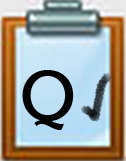Introduction
How involved should parents be in monitoring their children’s use of social media (social networks)? Parents want to feel their children are safe and making responsible decisions that are favorable to their future. Many students want privacy, or at least the ability to connect with their friends without having someone look over their shoulder. Is there a balance between these two positions? In this Quest, you are going to produce your own social media contract with guidelines you can share with your parents and with other students.
I Can Statement
- create a social media contract to share with others
Key Vocabulary
Reputation: Reputation is how you are viewed by people and by your community and the way these people think of you.
Social media contract: A social media contract is a list of guidelines for someone who posts content on a social network that a person uses when interacting with others in a social network.
Vocabulary Game
Play the interactive Quizlet Game: Direct Link
Steps
Begin by watching and considering this video before doing the activities below.
Activity One:
1. Read this article about Social Media Contracts or this one A Social Media Contract for Tweens and Parents.
2. After you have read through one of the articles reflect on the three statements presented.
- Note: If you are in class or learning virtually, your teacher may assign you to a group and have your group decide on a position using a 1-10 scale (1 = we totally disagree, 5 = we agree with some of it but have some considerations, and 10 = we completely agree).
- Reflect and support: As you reflect on and/or discuss each of the statements, identify your reasons to support your position.
- if working with others, have one person in each group capture the thoughts from each group member so that you are able to make a group recommendation.

STATEMENT ONE: Students should be at least 13 years of age to use social media sites such as Facebook, Snapchat, and Instagram.
STATEMENT TWO: Parents should have knowledge of any social media site their children use, including access to the username and password.
STATEMENT THREE: A social media contract is a good way for parents to set guidelines for social media use by their children.
Activity Two about Online Photo Sharing
Activity Two
1. Watch this video about Online Photo Sharing
2. Reflect on your own experiences with photo sharing and talk about it with others, whether you are in class or virtual discussion forum. Write down or post at least three reasons why it might NOT be smart to post and share photos in each of the following circumstances (what could happen that you didn't intend to):
a. Attending a party at a friend's house.
b. Making silly gestures.
c. Acting sexy.
3. Did you consider any of the following reasons?
a. A current job or future job application.
b. How it might impact your friends or family if they saw them.
4. Think about a few times you felt that you, or someone you know, posted or shared a photo that didn't seem to use good judgement. Did it make you feel uncomfortable or concerned? Should this be something to include in your own social media contract to be safe and smart about? If you are working in a group, share and collaborate on a document for this part.
Activity Three to Create a Social Media Poster
1. For your final activity in this Thing, you will create your own Social Media contract using Canva Poster Maker to create an online poster.
2. Follow your teacher's directions for creating an account in Canva, or use another tool as directed by your teacher. Note: Canva also has an iPad app.
3. Watch the video below and take some notes in the Thing 14 Social Network Reflections template provided in Quest 2.
Post-to-be Private (about oversharing information)
4. Using Canva (Canva Video Tutorial YouTube, Canva Design School Tutorial Videos) or another tool your teacher suggests, you are going to create a Social Media contract poster in which you list the rules you agree to follow when using social media, either now or in the future.
5. Review the notes you took as you watched the Do's and Don'ts in the Introduction as well as Post-to-be Private, and think about the things you have learned from the various activities you did as you went through this Thing. Be sure to sign your contract! You may be asked to present this poster to your parents for consideration or share it with other students, so be thoughtful about what you feel are the most important rules to follow when using social networks.
Completing this Quest
Share the link for your social media contract with your instructor (or post it following your teacher's directions).
Check off this Quest on the 21t4s roadmap
Option: Proceed to the Gold Quests in Social Networking
to learn more about:
- Texting
- Emoticons-Emojis
- Too Much Information (TMI)
- Red Riding Mood
I have completed the Quests as assigned by my teacher.![]()
Go to the graduation page for this Thing.
Competencies & Standards
MITECS Michigan Integrated Technology Competencies for Students, and
1. Empowered Learner
a. Articulate and set personal learning goals, developing strategies leveraging technology to achieve them, and reflect on the learning process itself to improve learning outcomes
b. Build networks and customize their learning environments in ways that support the learning process
c. Use technology to seek feedback that informs and improves their practice and to demonstrate their learning in a variety of ways
2. Digital Citizen
a. Cultivate and manage their digital identity and reputation and are aware of the permanence of their actions in the digital world
b. Engage in positive, safe, legal and ethical behavior when using technology
c. Manage their personal data to maintain digital privacy and security
6. Creative Communicator
a. Choose the appropriate platforms and tools for meeting the desired objectives of their creation or communication
d. Publish or present content that customizes the message and medium for their intended audiences
Websites and Documents
Websites
Videos from Outside Sources
- Canva Tutorial YouTube
- Canva Design School Tutorial Videos
- Online Photo Sharing from Commoncraft YouTube
- Post to be Private YouTube
- Social Media Netiquette YouTube
- When is the Right Age to Start Social Media? YouTube
21t4s Documents & Quizzes




